
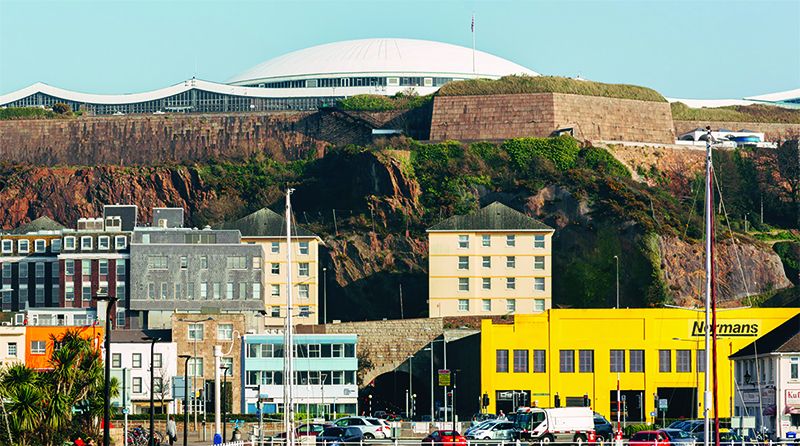

As Jersey's politicians settle down this week to make their plans for the island for the next four years, they would do well to glance up at the rather forlorn, but still imposing structure which dominated the St. Helier skyline.
The walls of Fort Regent could be reinforced with the number of plans for its future which have been imagined, consulted on and then shelved until the next time.
But that hasn't always been the case; it was once a cherished hub of island life.
Once upon a time, visitors young and old would spend their free time hopping into cable cars to visit the centre, quite literally buckling up for an afternoon of entertainment and adventure via funfair rides, concerts, an Olympic-size swimming pool and even an aquarium.
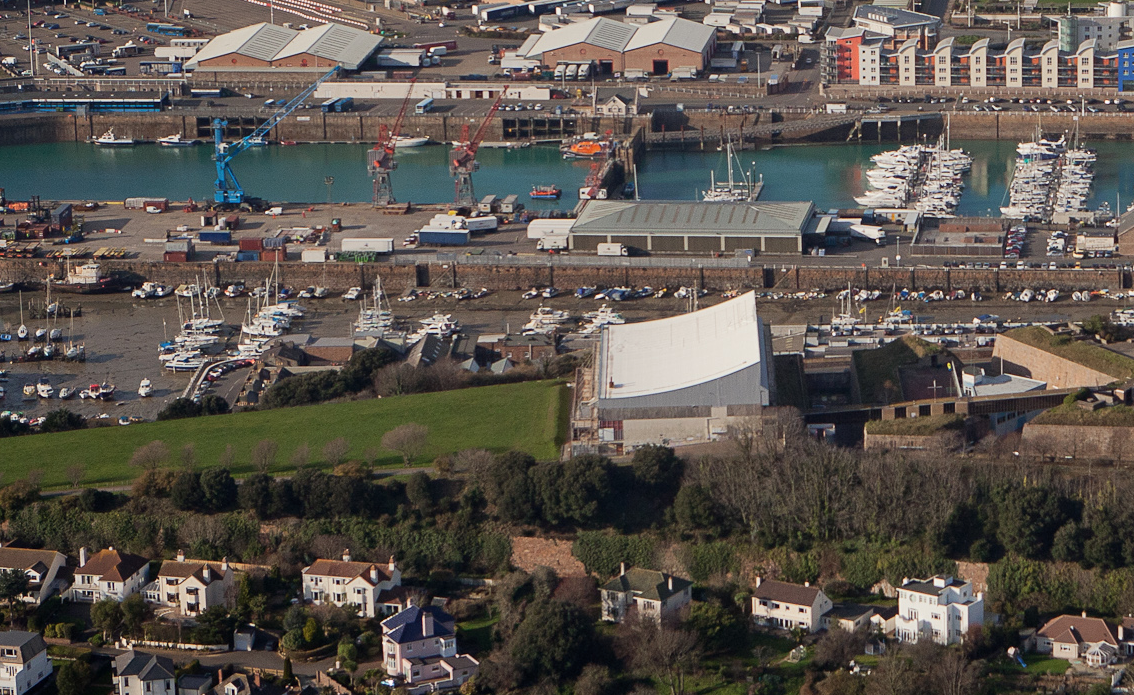
Pictured: The Fort has occupied a key place, both geographically and socially, in island life for many years.
But that prime period passed quickly. The decline in tourism mirrored by the Fort’s own physical deterioration, with amusements shutting one by one as new infrastructure problems were discovered.
It’s a phase in which the once great facility has seemingly been stuck for years – but crisis point has finally hit, and Ministers are now pledging to resolve its future once and for all.
Can what was once an island treasure be rescued from its ‘island embarrassment’ status?
Or, will it remain trapped in a ‘glory daze’ of indecision, with Ministers struggling to capture a lost past that cannot be translated into the modern day?
Express investigated...
Sue credits Fort Regent, in part, for the early arrival of her son.
It was 1981, she was “heavily pregnant,” and readying herself for Thin Lizzy.
But did she still manage to rock out to ‘The Boys Are Back In Town’ given her swollen state? “Most certainly did – he was three weeks early!” she jokes.
Others’ star-studded recollections of concerts past are themselves bejewelled with ‘like yesterday’ memories of outfits made of glistening lurex, sequins, tassels and skin-tightness.
“Weirdly, I can remember the white jeans, and where my mum bought them, that I wore to Depeche Mode supported by Blancmange,” Chris, who also enjoyed a performance from The Jam, notes.
Angela, meanwhile, remembers dipping into her mother’s make-up kit in preparation for Adam and the Ants.
“They were number one at the time, and the atmosphere was amazing. We used my mum’s white eye pencil to draw stripes across our noses.”
Liam’s favourite Fort-flavoured experience came at the younger age of around 10 when he saw Showaddywaddy. A keen bopper at the front, he was pulled on stage.
“I ended up getting the drummer’s drumsticks! …It was a great night. Such a shame how Fort Regent has been let go down the years!”
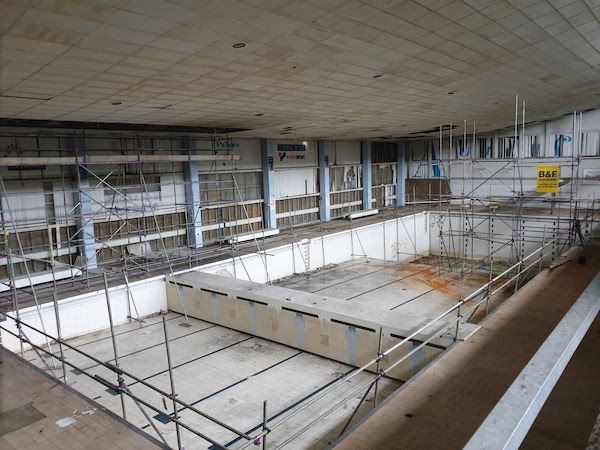
Pictured: Many islanders will remember using the old Fort pool.
His latter comment is what’s become a frequent addendum for the generation who were once the most avid consumers of all the Fort had to offer.
These days, the group finds itself similar in age to government decision-makers, lending an extra edge to the bitter disappointment that the bastion of their youth has been allowed to fall into disrepair.
As one former politician observed: “Few subjects arouse the passion of people in Jersey as much as Fort Regent. Its brooding presence over the town serves to continually remind people of its past and of what ‘could be’.”
The comment came from then-Deputy Roy Le Hérissier as many as 10 years ago in a report warning of imminent and potentially “irreversible decline” for what was once the centre of island life, if action was not taken soon.
But action was not taken.
The fervency of feeling he describes does go some way to explaining the reluctance from successive Councils of Ministers to decide what the Fort should look like, and offer in future: the matter is politically and emotionally charged, and a wrong call will hurt. A lot.
But this Council of Ministers has sworn it will be different. It has to be.
After all, there’s little left by way of entertainment at the 1800s fortress, that used to attract visitors from far and wide.
Nowadays, the site is described on Visit Jersey’s website as little more than a “dedicated children’s play area.”
It’s also home to a gym and sports hall, occasionally transformed for conferences, concerts and trade shows – both of which were recently threatened by the discovery of asbestos, legionella and fire risks, with the latter sparking an emergency cancellation of all events.
In early 2019, the facility – which currently costs £150 an hour to keep open – was described as a “ticking time bomb” in a £48k report by consultants Knight, Kavanagh, Page (KKP).
Mere months later, £500,000 had to be invested by the government for “essential” work to make the space safe.
It’s not that managers and politicians didn’t see the crisis coming – even as far back as the 70s, the late Colin Powell was advising the government to exercise commercial mindedness and invest in the facility.
Between 1996 and 2016, there was one major study every two to three years conducted by the government at costs ranging from tens to hundreds of thousands.
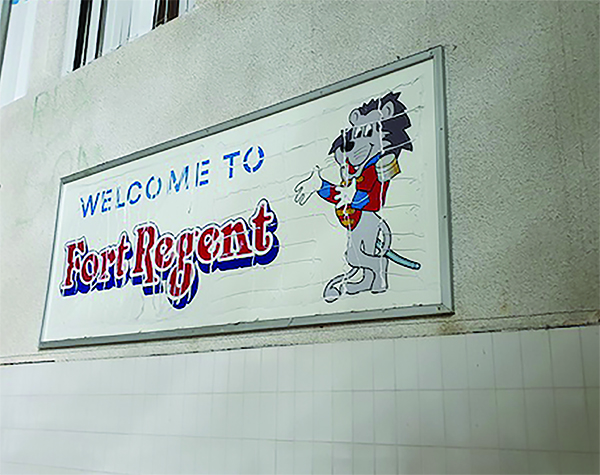
Pictured: The old Fort sign, which is to be preserved.
At the turn of the Millennium, there was talk of a ‘Sports Village’, followed by two reports on a potential ‘Conference Centre’.
Then came ‘Rediscovering Fort Regent’ in 2014, produced with the help of world-renowned HOK Architects and specialist venue consultants IPW.
Accompanied by designs dubbed spaceship-like, the proposals included an extreme sports zone, a luxury gym featuring treatment massage rooms, a gymnastics and trampoline area, a 25m pool, outdoor trail, gallery and conference space.
But, asked where things had got to in 2017, the Economic Development Minister, Senator Lyndon Farnham, dismissed the document as a “visioning exercise.”
According to the man now at the helm of the Fort Regent Steering Group, Assistant Minister Deputy Hugh Raymond, some of those ideas aren’t completely off the table.
His group is still working with IPW, which counts the celebrated Battersea Power Station regeneration, the V&A Dundee, the expansion of Liverpool FC’s Anfield Stadium, and London 2012 Olympic venues among its success stories.

Pictured: IPW, which is working on the future of the Fort, helped with the Battersea Power Station regeneration.
With the help of £2million set aside in the Government Plan, together, they’ll be bringing forward plans for a ‘preferred option’ for the Fort, supported by a Strategic Business Case, early next year. If the idea is welcomed, a more detailed business case – including full project costs and benefits – will be prepared.
An application for funding to make the idea a reality will then be made and voted on by States Members.
Ahead of that, the Steering Group has been inviting pitches from businesses keen to help shape the venue’s future.
The first call-out was for a company to “create events and experiences” to attract islanders to the Fort in the medium-term, and the second for a company “to provide practical commercial advice on the long-term options”.
“The interest is in double figures,” Deputy Raymond excitedly explains adding that it has come from, “everywhere… even people wanting to build a film studio!”
He adds that the ‘C-word’ that previously sparked division and outcry from the religious lobby has also been considered, though casino case studies in Dinard and the Isle of Man suggest that gambling enthusiasm may be waning.

Pictured: Deputy Hugh Raymond, who is leading the Fort Steering Group.
It therefore hasn’t made the list of key “themes” being put explored by IPW – one of which is a “world-class” botanical gardens concept.
Benefiting from the Fort’s sweeping views, the Battersea Park-style amenity could also feature a performance space and “low-scale sports intervention”, such as putting or a skatepark.
But the idea currently proving most “attractive”, Deputy Raymond says, is an amalgamation of themes: a hotel with a conference space and sports facility.
He won’t name names, but teases that “one of the bigger hotels has already shown an interest.”
With Jersey Airport due a £40million upgrade, the move would anticipate a resulting visitor surge, and respond to the demand for quality affordable accommodation evidenced by Premier Inn’s rapid local ascent.
The conference element would also take advantage of Jersey’s £1.4bn finance sector and its IFC connections.
Tapping into the growing corporate events market would be a savvy move.
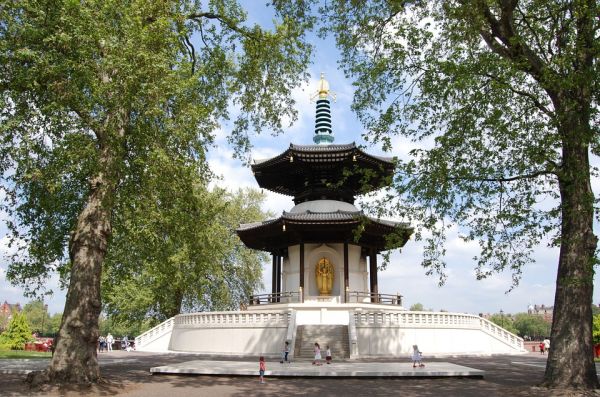
Pictured: A pagoda at Battersea Park, which is providing inspiration for the Fort project.
1.3m business events are held every year in the UK, with corporate hospitality hauling in £1.2bn for the economy and trade shows a staggering £19.2bn.
‘Music tourism’ is also on the rise, and a quality Fort performance area could finally refill the space echoing with memories of ‘The Jam’ with the cream of tomorrow’s talent.
Sport will, “of course”, also be a feature. “Lots of hotels have a pool or ‘keep-fit’ element,” the Deputy notes.
He adds that there is Ministerial appetite to re-introduce a pool, given that government grant-funded SERCO’s Aquasplash lease expires within the decade.
Whichever sports are incorporated, if any, will have to be carefully considered alongside the findings of a new KKP facilities review due before year-end.
It was commissioned by a Sports Facilities Strategy board, which is considering the creation of a ‘national stadium’, as well as sourcing homes for Jersey Netball (soon to be “homeless”) and gymnastics (currently at the Fort).
It’s led by Senator Steve Pallett, who concedes that losing the Fort – home to dozens of clubs, and the recently-opened Jersey Sports Foundation training facility, which is helping create world-class athletes like Team GB weightlifter Charlotte Neale (15) – would “be challenging”.
KKP’s reviewers, he says, have “regularly” visited the island, meeting sports clubs to “understand their needs”.
But how to ensure that the Sports Strategy and Fort Steering Group don’t come up with clashing options for the area?
“Politically, I’ve agreed certainly with the Director General [who oversees both projects] that those groups need to work more closely together,” Senator Pallett explains.
“I need to ensure the work we’re doing fits in with what the Fort Regent group are doing. That could mean us joining the groups or more overlap between the groups politically.”
The civil servants working on both sides of the project fortunately overlap, he notes, so can bring their expertise to both.
Keeping sport within the Fort does seem a wise idea – it could, after all, build on the event momentum of Super League. And sport is, after all, one of the few sectors of the UK economy not due to be hit by Brexit.
Both Assistant Ministers speak excitedly of the future, but how do we know that the final proposals won’t flop – again?

Pictured: The Fort costs £150 an hour to keep open
Well, a “realisation” has occurred, Deputy Raymond explains. “It used to be, ‘What’s in it for us?’”
But the government is now operating with “sustainability” at the forefront of its mind, he says, and isn’t concerned about trying to run the Fort itself with a view to generating revenue – they’d rather hand it to a provider that will run it properly.
“It’s very sentimental. The Fort means a lot to a lot of people… We are not selling it – that’s important – we want someone to look after it… Even if it’s £1 for 25 years. It’s all about getting the Fort full again. The underlying thing is that we don’t want it to shut.”
The first hurdle, according to the Director General of Growth, Housing and Environment, John Rogers, is “access and access and access”.
He recently told a Scrutiny Panel: “Once you have got access, the great thing about Fort Regent is it is a massive site and it is over many acres and I think it can fulfil a range of solutions… The main thing we are progressing initially is access from Pier Road and from Snow Hill and we are looking at two concepts there, where we are basically building accommodation and then that will pay for public access, either attached or alongside it. Once you have got access, then Fort Regent becomes, I think, a viable space again for the big conurbation that is St. Helier.”
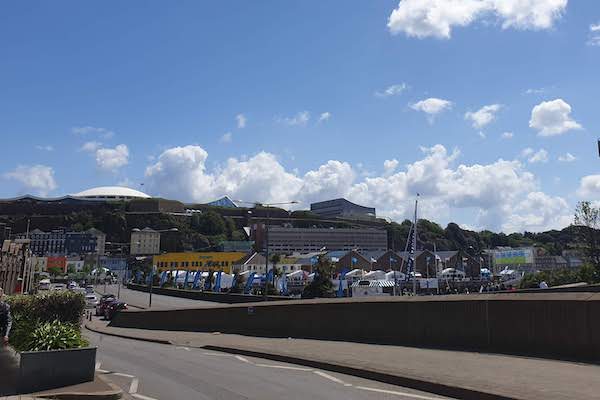
Pictured: How would the town skyline look without the iconic dome?
Of course, the big question will always be the size of the pound sign attached to the project and where the funds inflating it come from.
At the moment, there’s talk of a potential ‘Jersey Infrastructure Fund’, which could see foreign investors get involved.
External Relations Minister Senator Ian Gorst told Scrutiny recently: “…I have travelled around the world people have asked me: ‘What can we buy in Jersey?’ Historically, I have said: ‘No, we are not selling things, we are not asking you for that sort of investment...’”
But investors might also be found closer to home, he noted.
“From my conversations with individuals, there are plenty with considerable amounts of money that if that strategy was in place and such a fund was in place, Jersey residents would want to invest in it, because they would see it as a positive contribution back to their community.”
There’s plenty of encouraging sounds from government, but they will no doubt still elicit sighs of, “Never gonna happen,” from islanders.

Pictured: Senator Ian Gorst, External Relations Minister, said investors from near and far may be interested in helping finance a Fort regeneration.
Hopefully, then, Deputy Raymond’s pledge to “get on with it” will ring true.
One only needs to look to the visually similar Millennium Dome for inspiration.
It cost around £600m to transform the UK government’s ugly duckling into a swan since AEG’s takeover in 2002.
Now the most popular venue in the world by ticket sales, the O2 has gone on to host world stars and Olympic events, turning a profit every year for a decade – nearly £150m since its redevelopment.
Food for Fort indeed.
This article first appeared in Connect Magazine, which you can read in full by clicking here.
Comments
Comments on this story express the views of the commentator only, not Bailiwick Publishing. We are unable to guarantee the accuracy of any of those comments.